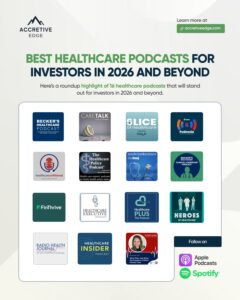Almost every investor meeting involves this question at some point: “Walk me through your market size.”
Founders almost usually respond with some version of: “Healthcare is a $4 trillion market, and digital health is growing fast. We think we can capture 2% of that.”
The slide looks good and the numbers are big. But the conversation tends to stall right after.
That’s because many market sizing slides don’t tell investors anything useful. And they don’t help the founder either. They’re either inflated — “we’re a fit for everyone” — or disconnected — “ we have no idea how we’ll get there.”
The real goal of market sizing isn’t to impress, but to focus. When done right, it becomes a tool for shaping your go-to-market strategy. It helps you figure out who your actual buyer is, what segment they live in, how much they’re worth to you, and what it will take to win them.
And in healthcare — where the buyer and user are often different, and budget cycles don’t play by SaaS rules — that kind of clarity can make or break your commercial plan.
This article will show you how to size your market in a way that’s not just fundable, but actually usable. We’ll look at what TAM, SAM, and SOM really mean, where most founders get tripped up, and how to tie those numbers directly to the way you plan to go to market.
What TAM, SAM, and SOM actually mean — and what most founders get wrong
If you’ve ever sat through a pitch review, you’ve probably heard these terms thrown around like they’re interchangeable. But they’re not. And getting them right shows that you actually understand your market and how your business will grow inside it.
Here’s a simple way to break it down:
TAM: The Outer Limit
TAM is your total addressable market. It’s the theoretical ceiling — how big the market could be if every possible customer bought your product, with no constraints. It’s useful for understanding the overall size of the space you’re in. But it has to be specific, or it’s just noise.
Some teams quote the biggest number they can find — “Healthcare is a $4T industry” — without narrowing it to something that actually maps to their product or model. That doesn’t help. It shows a lack of clarity.
A credible healthcare TAM does three things:
- Anchors to your actual category (e.g., RPM, not “digital health”)
- Reflects the geography you’re selling into (U.S. vs global)
- Aligns with how your solution gets paid for
If you’re building an RPM tool for diabetes management, quoting all of telehealth or digital health as your TAM just creates confusion. The better move is to say: “We’re targeting the $14B U.S. RPM market, starting with chronic disease — specifically diabetes, where 37M patients are eligible.” That’s more focused and credible.
SAM: Where You Can Actually Sell Today
SAM is your serviceable available market — the part of the TAM that your product is built to serve right now. This is where your design constraints, workflow choices, and GTM decisions start to show up.
We look at SAM as your current commercial scope. Who are you actually able to reach, sell to, and support based on your:
- Integration requirements (e.g., must run on Epic)
- Buyer persona (e.g., outpatient clinics, not hospitals)
- Delivery model (e.g., virtual-first, reimbursed via RPM codes)
A good SAM sets a clear limit around the market you can reach today. Many teams go too broad, assuming any clinic or hospital that could use their product should be included. But in healthcare, things like how care is delivered, how buyers make decisions, and who controls the budget all matter. These limits make your real market smaller, and more useful.
Let’s say you’re selling a remote monitoring solution for cardiology clinics. If your platform only integrates with Epic and is designed around Medicare RPM codes, then your SAM isn’t “all cardiology clinics.” It’s the subset of outpatient cardiology clinics using Epic and billing for RPM. That’s a smaller number, but it’s grounded in how healthcare actually works.
Other factors matter too: state Medicaid policy, local contracting thresholds, or whether your buyer even has the authority to purchase new tools. These things can shape or shrink your SAM. That’s not a problem. It’s the kind of clarity you need to build a go-to-market plan that’s executable.
When teams get this wrong, it usually shows up in two ways:
- The SAM is still too abstract to support a pricing model
- The SAM doesn’t line up with how the company actually plans to go to market
That disconnect may show up in diligence — and stall deals that otherwise should’ve moved forward.
SOM: What Your GTM Team Can Realistically Land
SOM is your serviceable obtainable market. It’s not what the market could deliver. It’s what you can realistically win over the next few years, based on your current sales motion, pricing, and channel strategy. That number should reflect:
- Your actual sales capacity
- Your current sales cycle length
- Your win rate and average deal size
- Your channel leverage (if any)
We always push teams to ground this number in execution. A common mistake is to say, “We’ll capture 5% of the market,” without showing how. But SOM isn’t just a percentage, it’s a sales plan. If your SAM includes 10,000 clinics, and your team can realistically reach 500 of them over the next two years, with an average contract value of $10K per year, then your SOM is $5M. That’s the number that matters — and the one that needs to line up with your go-to-market model.
This approach does two important things:
- It keeps your revenue model honest — which matters in boardrooms
- It keeps your pipeline expectations grounded — which matters for your team
One way to stress-test SOM is to map it against sales headcount, cycle length, and win rates. If the number you’re using can’t be supported by your actual capacity, that’s a red flag — for investors, but also for internal planning. If your team is chasing a number it can’t realistically hit, it can throw off forecasts, hiring, and morale.
In short, SOM should match your go-to-market model line by line. If it doesn’t, it won’t hold up in a pitch deck, and in real life.

Some early-stage digital health teams either camp out in TAM and hope the size of the number will carry the pitch — or try to look conservative by jumping straight to SOM without explaining how they got there. Neither works.
What investors are looking for is logic. They want to see that you understand the big picture, but that you’re clear-eyed about where you’re starting and what it will take to get traction. They want to see the math, not just the magnitude.
This is especially true in healthcare, where buying cycles are slow, segments are fragmented, and one-size-fits-all rarely fits anyone.
So before you build your market sizing slide, ask yourself a few basic questions:
- Are you clear about which part of healthcare you’re actually in? (Telehealth is not the same as remote patient monitoring or digital therapeutics.)
- Do you know which buyer persona holds the budget for your product?
- Can you show how the revenue from those buyers adds up to a credible number?
If not, your TAM/SAM/SOM breakdown probably won’t help you. It may just raise more questions than it answers.
How to Size Your Healthcare Market in a Way That Actually Supports GTM
If you want your market sizing to support your go-to-market, you have to flip the process: start from the way you sell, and build outward. That means grounding every part of TAM, SAM, and SOM in the actual constraints of how healthcare gets bought — and by whom.
Here’s what that looks like.
Start Bottom-Up — Then Pressure-Test Top-Down
The cleanest path is often in reverse: start with what you know.
- How many buyers exist in your specific segment?
- What can they pay you, based on your current model?
- How many of them can your current team reach, sell to, and support?
This gives you a bottom-up view of SOM that’s rooted in execution. Then you can use top-down research to pressure-test whether the broader market size matches your assumptions. If it doesn’t, the gap usually tells you one of two things: either you’ve misestimated the size of your wedge, or your solution may need to expand its scope or value prop over time.
But the key here is, top-down doesn’t lead. Bottom-up drives the model. That’s what separates GTM-aligned sizing from pitch-deck theater.
Segment By Reality, Not Just Logic
In healthcare, segments are often defined on paper — “ambulatory,” “payer,” “chronic care.” But the most helpful segmentation is based on how buyers behave. That includes things like:
- CPT code eligibility
- Budget ownership (e.g., who controls chronic care dollars)
- Workflow complexity (does your product disrupt or extend?)
- Readiness to adopt (tech maturity, EHR compatibility, quality incentives)
So if your SOM includes clinics that should buy but haven’t demonstrated intent or readiness, it’s better to cut it. If your SAM includes health systems that won’t even consider a vendor without a two-year pilot, that’s a different tier of opportunity — and likely a different GTM motion altogether.
The Real Test: Can You Price, Plan, and Pipeline Off This Model?
Your market sizing doesn’t need to be perfect. But it does need to be functional. If your board asks how this ties to your pipeline model — or if your CFO asks how pricing aligns with segment spend — your TAM/SAM/SOM breakdown should help answer those questions.
In healthcare, sizing your market isn’t about staking a claim, but about staging your path. And to win, you don’t need to always be the one with the biggest numbers. Just have a clearer plan to go get them.
Final Thought: The Slide is Just The Start
Market size isn’t just a slide you make for investors. It’s a lens you use to focus your whole GTM strategy.
When it’s done right, it helps you make real decisions. Where to start. Who to hire. What pricing fits the buyer. What messaging lands with the right stakeholders. Which parts of the market to ignore, for now.
So build it carefully. Then use it often.
If you know your segment, your buyer, and your path to revenue — you’re not just pitching better. You’re running a better company. And that’s what gets funded.
If you’re trying to build a market sizing model that actually supports go-to-market — not just investor optics — we can help.
At Accretive Edge, we work with digital health founders to develop sizing models that hold up in diligence, map buyer segments based on how budget actually flows, and align serviceable obtainable markets to real-world sales capacity and pricing strategy.
If that’s where you are, we’d be happy to talk through it. Get in touch.






